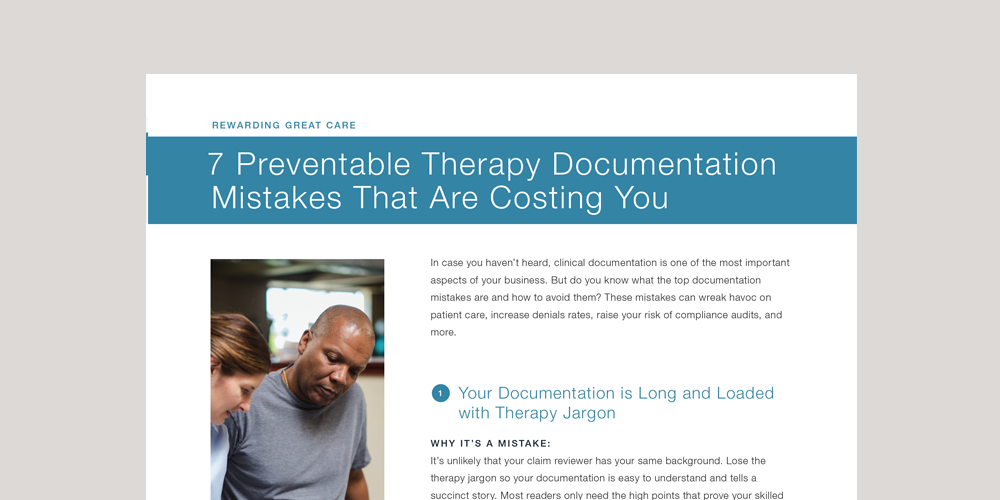Over the years we’ve noticed some unique characteristics in therapists around how they approach documentation. Some write in lengthy prose and others require you to pick up a dictionary to understand just what they are talking about. Luckily we’ve gathered some simple tips over the years to help just about anyone improve their documentation. Do any of these descriptions match you or a therapist you know?
The Seven Types of Documenters
1. The Professor: Ever felt like you needed to grab a dictionary just to understand someone’s documentation? That’s how you know you have a professor on your hands. This therapist writes using long academic jargon and assumes that the reader has a robust therapy background and degree.
Unfortunately, that’s not usually the case. It’s important to check your language and write documentation in layman’s terms that anyone—regardless of their background—can understand.
2. The Generalist: Have you ever read a therapist’s documentation and thought, so what? Well that might be what comes to mind when working with a generalist. Unlike the professor, this type of documenter writes using very broad statements without including specific goals for their patients. This type of documenter also commonly forgets to relate clinical findings and short-term goals to functional deficits and specific long-term goals
If you’re this type of documenter what should you do? Get specific about the goals for each patient. Explain the necessary skilled interventions used to treat the patient and make sure to relate it back to their functional goals.
3. The Pinball Player: Boing, boing, boing. Are you familiar with documenters who bounce from one point to another? We call this the pinball player. Unfortunately, this type of documenter fails to connect the dots and often misses the specific goal – even if just by a hair. Though it is similar to the generalist, this type of documenter needs to get organized.
The problem with missing specific goals, even if only by a little? It becomes nearly impossible to establish the relationship between clinical findings and functional goals. Our tip? Get your documentation organized so it can establish your patient’s story of recovery. Following the what, why, how and when format is a good place to start.
4. The Rambler: Documentation that could compete with Moby Dick? We call that the rambler. This style of therapy documentation doesn’t follow a clear path from beginning to end of the episode of care and isn’t quite sure when or how to wrap itself up. The main difference in this style is that the therapist might be including all of the necessary information but it’s swallowed up in a sea of information that only a devoted reader can get through.
When in doubt – BLUF! (Bottom line up front). This is a great mantra to keep in mind when completing your documentation (and can also apply to your writing outside of documentation). The idea here is to write smarter, not longer. Learn to summarize key findings and focus on the big picture without extra color commentary.

Are you making documentation mistakes? Download this free tip sheet to learn seven of the most common documentation mistakes and how to prevent them.
Download Now5. The Procrastinator: Work-life balance, what’s that? This documenter rarely, if ever, completes their documentation at the point of care making it easy for them to forget important patient care information. They are also guilty of bringing documentation home at the end of the day or on weekends.
Our tip? Start documenting at the point of care so it becomes a habit. Use efficient documentation tools that make it fast and easy to document and keep you connected to your patient.
6. The Rebel: Medical necessity requirements, functional limitation and quality reporting – do I really need to pay attention to those? Okay rebel, back away from the documentation because yes you do. This type of documenter doesn’t fully understand the importance of tracking or including Medicare required elements in their therapy documentation so they may not pay as close attention as they should.
Believe it or not, there is an easy fix for this – simplify your Medicare reporting. Using a system that provides easy tools to automatically track, prompt and alert therapists of Medicare requirements can turn any rebel into a rule follower.
7. The Ace Reporter (aka The Henderson): Finally, we have the ace reporter – or what we more lovingly refer to as The Henderson (a la Clinicient co-founder, Jerry Henderson). This type of documenter writes in clear, concise and direct language. They know how to tell short, meaningful stories that anyone can understand and, bonus, they know the importance of and accurately track Medicare requirements.
In documentation terms, we should all strive for the Henderson. Understanding the right combination of storytelling and direct language will help you connect with the reader, which will tend to result in a positive outcome for you. Share your knowledge and tips with other therapists to improve documentation across your entire clinical team.


Comments